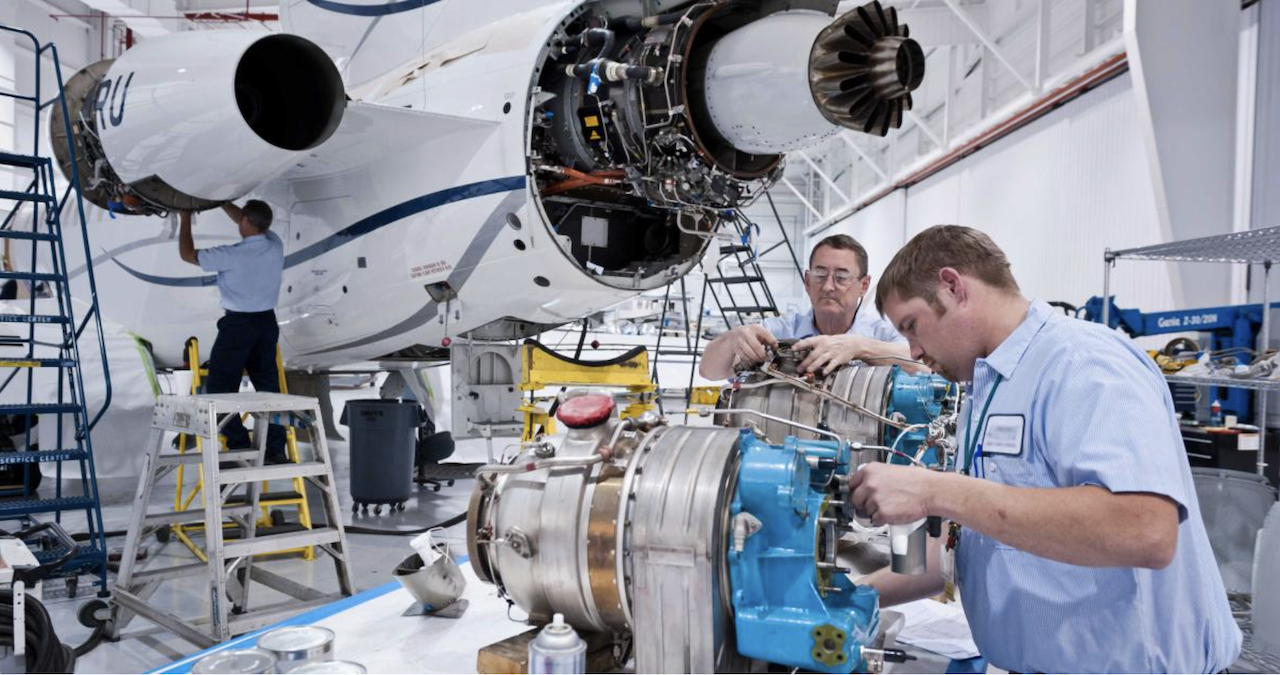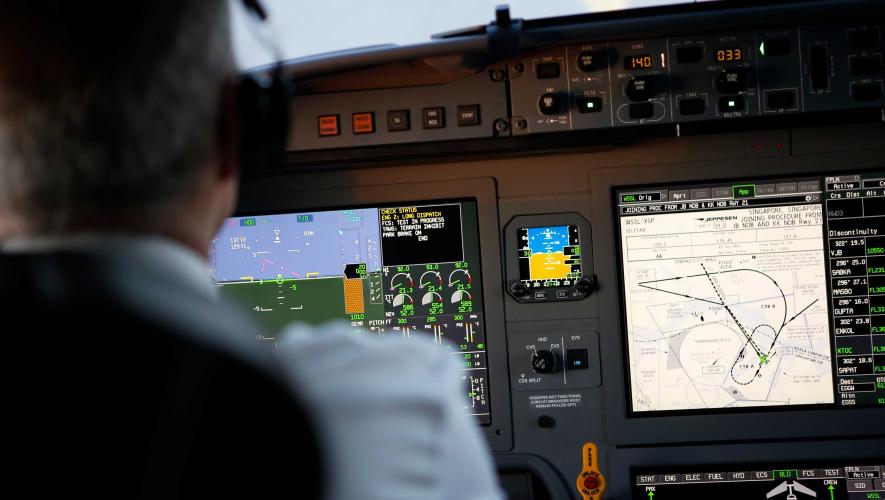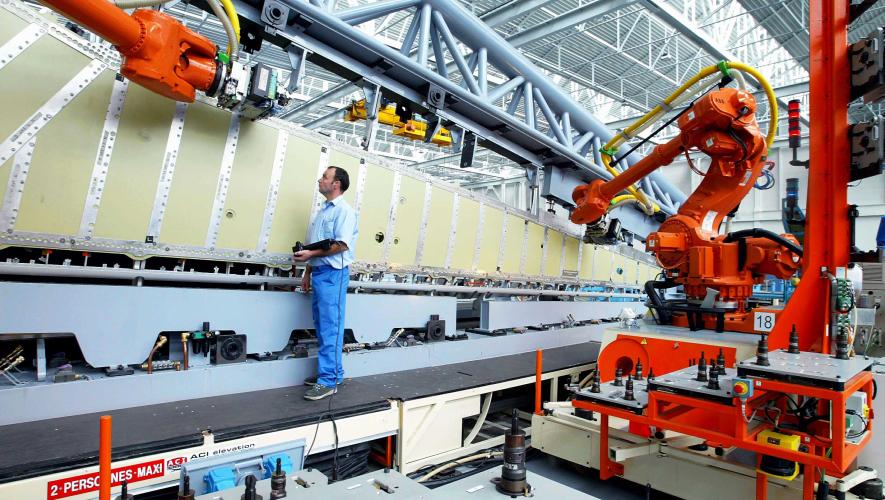
Kerry Lynch’s following article about “workforce woes” and the related business aviation talent shortage originally appeared in Aviation International News. View here.
The personnel shortage is particularly acute for business aviation MROs, with airlines and other industries offering mechanics attractive incentives.
When it comes to describing the workforce situation, General Aviation Manufacturers Association (GAMA) president and CEO Pete Bunce is plaintive: “Our industry is sucking wind.”
The industry has struggled to fill factory floors, engineering desks, and especially maintenance shops. And, while the pipeline is better, pilot positions remain a concern.
For the FBOs, the strain has eased a bit, said Steve Berry, v-p of safety and education for the National Air Transportation Association (NATA). “When it comes to line service, customer service representatives, the more traditional FBO positions, the hiring seems to have to have lightened a bit,” Berry said, noting that applications are up an estimated 10 percent. Even so, with increased traffic, FBOs still feel a pinch. “We’re not quite back to where we were pre-pandemic levels.”
Bunce points to numerous reasons for the workforce pains, starting with the fundamental changes that occurred thanks to the Covid pandemic. “Our society has changed pretty dramatically since Covid,” he said, with the sheer number of people available to the industry shrinking as many workers have retired or moved on to other disciplines.
Further, as people transitioned into remote roles during the pandemic, most aviation positions must be onsite. “People have to come to the office and go to work each day, whether they’re doing maintenance or manufacturing,” Bunce said, noting that this has been a disincentive to attracting new people.
Workforce pain points are felt in both commercial and private aviation, and even in aerospace. But as larger airlines feel squeezed, there is a trickle-down effect.
When it comes down to it, Bunce added, “We’re the competition.” Business aviation has found competition with airlines for pilots and mechanics. But beyond that, the sector, and the industry at large, also is competing with a range of other industries for workers.
Industry leaders have long discussed aerospace engineers graduating from universities such as Embry-Riddle Aeronautical University only to get snatched up by “cooler” career paths such as those at Disney. Factory workers now are returning to auto and other manufacturers that have come up with more lucrative contracts.
In recent years, FBOs found themselves losing candidates to the fast-food chains that raised their entry-level salaries. Now it’s the Amazons and the big box stores, added Alan Stephens, v-p of regulatory affairs for NATA.
As for pilots, they are getting trained and gaining experience in business aviation and then getting quickly lured away by high-salaried positions at the airlines as those carriers look to fill their pipelines. This makes the pipeline fill all the more difficult in business aviation.
And everyone is struggling to find maintenance technicians. As with pilots, this creates a pinch on business aviation. Companies may help students go through the technical schools, but once they are A&Ps, “they get poached by the airlines with big signing bonuses and everything else,” Bunce said. “We’re working that issue hard.”
“Maintenance is where we’re seeing the biggest bottleneck,” agreed NATA’s Berry, who noted that one member cited three MROs on its field that are having to restrict business because of a technician shortage. “They’re having to turn people away because they simply do not have the staff to maintain and keep up with it,” Berry said. “We’re going to go from an issue where there’s not enough pilots to keep planes in the sky to there’s not enough mechanics to get them off the ground.”
From the corporate standpoint, Sheryl Barden, president and CEO of Aviation Personnel International, said, “I’m not seeing it getting any better in our segment of the industry.” This is true for both pilots and mechanics.
“On the pilot side, the airline pull is so strong. We used to fill the pipeline with younger people starting as a first officer or flying charter and then moving up [into corporate jobs]. If we’re not able to bring those people in because there’s so much airline pull, then how are we going to fill for the future?”
Flight schools are staying busy, Barden maintained. “We’re making more pilots as a country,” she said, “but we haven’t started to fill the pipeline yet.”
The process is long for airlines, with pilots needing a minimum of 1,500 hours, but also for corporate flight departments, many of which have standards at least the equivalent of the airlines.
Bunce also noted an uptick in flight schools. “We all know the training centers are pumping out a lot of people.”
However, many of those are ab initio through contracts with airlines, underscoring the ultimate career trajectories for those students.

Student Pilots on Increase, Mx Techs Decline
According to the latest available FAA data (for 2022) as of AIN’s magazine deadline, student pilot certificates have more than doubled over the past decade—from 120,285 in 2013 to 280,582 in 2022. ATP holders have also increased over that period, from 149,824 to 166,738.
However, at the same time, the number holding commercial certificates has dipped from 108,214 to 104,498. Meanwhile, statistics surrounding maintenance certificates are more concerning, dropping from 338,844 in 2023 to 320,042 in 2022.
Workforce throughout the industry has been such a worry over the past decade that Congress commissioned a committee—the Youth Access to American Jobs in Aviation Task Force—to provide recommendations and strategies to encourage students to pursue studies and careers in aviation and aerospace.
Citing Boeing and Airbus forecasts, the task force noted that before the pandemic, the aviation industry was facing “a 20-year stretch of unprecedented need for qualified employees.”
The task force further noted that consultancy Oliver Wyman in 2022 followed with a finding that the tight labor market extends beyond flight crews. “It also reflects staffing problems in the ranks of ground staff, baggage handlers, air traffic controllers, TSA agents, and vendors…A stunning 85 percent of senior executives in Oliver Wyman’s annual maintenance, repair, and overhaul survey said that finding new hires was their biggest challenge.”
McKinsey and Company painted equally a dim picture, according to the task force, saying, “an industry with 50,000 unfilled positions is losing staff at a rate of six percent higher than other sectors and at the same time is losing in recruiting new talent due to factors including a failure to compete with tech companies’ pay rates that, for example, typically run twice as high for software engineers.”
These pressures will only worsen, McKinsey contended, as the burgeoning advanced air mobility market increases.
The question is how to fill the pipelines and train the workforce so there is a steady replenishment. The task force pointed to McKinsey’s contention that identified an urgent need for a new approach to attracting and retaining a workforce.
Key to success is expanding the available pool, the task force maintained. While not unique to aviation, the industry had been “slower to understand and act upon creating a more equitable and inclusive workforce,” the task force said.
This includes working to draw in more women and people of color. “Outreach to underrepresented groups is paramount,” the task force said.
Ultimately, the task force came up with recommendations to create a sustained pilot pipeline that fall into four major categories: engage young people at an early age (“waiting until high school is simply too late given that awareness [and] financial support are two of the significant barriers”); ensure easy access to resources for caregivers, teachers, guidance counselors, and young people; elevate collaboration with a connected career pathway to collectively draw students into aviation and aerospace; and find sustained funding.
The task force conceded that the last category is likely the most difficult, but stressed: “There is no one solution [that will] solve our workforce challenges, particularly where the lack of representation from women and minorities is concerned. It must be—and will be—a multi-solution approach where some opportunities will happen more quickly with some having greater impact.”
While funding may be the most difficult to crack, Bunce and Barden pointed to recommendations surrounding collaboration to provide a connected career pathway as an imperative for business aviation to develop a sustained flow of talent.
They cited numerous initiatives underway to bring in new talent. Aviation trailblazer and advocate Barrington Irving partnered with industry and community organizations to launch a professional and technical training center in South Florida to help develop local, national, and international students in business aviation disciplines.
Famed aerobatic show pilot Sean Tucker teamed up with local officials in Salinas, California, to launch the Bob Hoover Academy to offer flight and other technical training. There are a myriad of other programs from after-school and local clubs to museums and even large entities such as NASA and the U.S. Air Force.
And then a multitude of companies have started to partner with technical schools to create internships and facilitate apprenticeships. In the maintenance arena, many of the major providers—such as Duncan Aviation, West Star Aviation, and Constant Aviation—recognized early on the labor shortage potential and established such programs. Meanwhile, other operations such as Jet Aviation have established relationships with universities to fill its needs, the company said. ACI Jet even helped build a new A&P school.
The same holds true with flight departments, Barden noted. “We have some flight departments who are doing a fabulous job of bringing in pilots much earlier in their career.”
These organizations create what she likens to an ab initio program for corporate pilots with mentorships to help develop them. “The departments that are doing that are making huge investments of time and energy.” This requires three or four pilots per every one low-time pilot, she said.
Barden also stressed the importance of internships. “They really are the way to help this next generation uncover all of the very amazing and cool things that are part of business aviation,” she said. “Whether it’s an internship in maintenance or whether it’s an internship in the flight department at any level, pilot scheduling, the experience and the exposure is outstanding.”
These lure not only prospective new workers but, in an era of social media, help with outreach. “This generation coming out, they love to share their experiences. So, with every positive internship experience you have, we’ll get a fan who Snapchats and Instagrams about it and starts to bring awareness.”
But while all these programs, initiatives, internships, and apprenticeships draw in people, Barden cautions, “It’s not mass production.”

Bringing It Together
Barden contends that the industry needs a major, well-synchronized marketing campaign. The “Holy Grail” is to have a coordinated industrywide effort to take the message of business aviation to prospective talent in a well-orchestrated, strategic way.
“That story is still very much being done on a very grassroots basis [in business aviation],” Barden said, highlighting efforts of the majors such as United Airlines, American Airlines, and Delta Air Lines. “They’re all out every day telling that story at the Embry-Riddles, the UNDs [University of North Dakota], the Auburns, and the Purdues, and they’re telling it with a well-honed marketing strategy. We are still a group of small, more grassroots messages that are not fully coordinated.”
NATA’s Stephens agreed. He noted that, to help coordinate efforts for maintenance shops, NATA worked with its maintenance committee to create its Aviation Apprenticeship Tracking Tool to help them develop “test-ready and well-documented” technician applicants.
While reactions have been favorable to the apprenticeship tool, he stressed, “That is just one piece of it. If we can get some of the aviation community together, especially in general aviation, to incentivize people to come into maintenance, to get that hook in, now you have a plan to go from here to there.”
Bunce further agreed with this sentiment and, in fact, is contemplating how to better coordinate these efforts. He noted that GAMA is exploring ways to build a network that ties different programs together around the country. On the maintenance side, “What are the apprentice type of programs that can help bring someone through to their A&P while they’re making money working in the industry?”
GAMA hopes to explore tying together best practices and resources of what is available. “Ideally, we will have a continuum,” Bunce said. While still a concept, he cited as an example a young person who gets a flight through the Experimental Aircraft Association’s Young Eagles program, and their interest is sparked. Then, their parents, educators, and others are given resources about pathways, schools with programs, and communities that can support their goals. Such a network could point to schools that incorporate the Aircraft Owners and Pilots Association’s STEM curriculum.
“We’re trying to network all of those as well as programs at the museums,” he said. For the engineering side, such a network could pull together initiatives like what NASA does involving young people along with those transitioning military personnel and local people looking for new avenues.
“Here are all these different components and modules that industry can get,” Bunce said. “But what is lacking is something to stitch all of these good programs together and share the wealth and knowledge. That’s what we would like to create.”
Dollars and Sense
Once the recruitment side is addressed, Barden said, then it falls on retention. Wages are a key piece, she noted.
NATA’s Stephens pointed out that compensation has long been an issue. In the mid-1990s, he served as a maintenance officer commander in the National Guard in Memphis. FedEx had just picked up a postal contract and hired away nearly two dozen of its full-time maintenance employees, offering salaries of $35 per hour. The Guard’s top salary was $22 an hour. “They were also sucking up the pilots that we had,” he said. “So, anybody that was trained that was good, they were going over, and rightfully.”
The difference between then and now, he added,is that “the pipeline was charged up and we had people coming into the pipeline. Now, the question is, do we have the [maintenance technical] schools being filled? Anecdotal information we’ve been getting is no.”
“Obviously, you are going to have to raise wages to compete for this limited labor supply,” Bunce said. But he added, “It’s happening organically.”
In fact, NBAA’s 2023 compensation survey, which involved data on 3,442 flight department employees, showed a 12 percent increase in pilot salaries with the average captain receiving a long-term retention bonus of around $27,000 a year.
But there are other incentives to draw and retain workers, from playing up the industry’s own “cool” factor to promoting environmentalism. To that end, companies such as Jet Aviation said they are altering their training to fold in environmentalism.
Others have turned to new technologies for training, such as the use of virtual reality for pilot training at Embry-Riddle. But the flight schools are not unique to that. Signature Aviation is planning to test out the use of virtual reality training in basic areas such as wing walking and marshaling.
“Attracting great talent is always a challenge for any company, regardless of industry, and what matters to candidates continues to evolve,” said Amy Alexy, chief people officer at Signature Aviation. “That is why we’ve worked hard to provide a more seamless candidate experience and offer competitive benefits. When they do join us, we want them to feel as if they’ve always been a part of the Signature family with a great onboarding and new-hire training experience. For example, we’re excited to soon pilot virtual reality to make basic operations training more interactive and engaging.”
To boost many of the educational efforts, Congress in the 2018 FAA reauthorization bill created a grant program that provides $25,000 to $500,000 to entities that foster the development of pilots and maintenance technicians (for a total of $5 million in grants awarded in a given year). While sunsetting last year, the FAA reauthorization bill that has been under consideration in the House and Senate (still not finalized as of the magazine deadline) would renew the program and expand those grants to manufacturing.
Bunce said GAMA was watching that provision closely, among the many initiatives that the association—along with all of its counterparts—have undertaken to prepare the next generation of the workforce.
“We’re trying to come up with any ideas we can to look at because, when you look at it demographically and age-wise, we’ve got to recapitalize this workforce.”
To read more of API’s viewpoints on the talent shortage, check out these articles.
